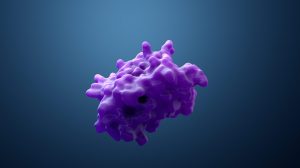Table of Contents
Definition
noun
plural: guanosine monophosphates
(biochemistry) A nucleotide composed of guanine, ribose and a phosphate group, and with a chemical formula: C10H14N5O8P
Details
Overview
A nucleotide is an organic compound made up of three subunits: a nucleobase, a five-carbon sugar, and a phosphate group. The sugar component may either be ribose or deoxyribose. The ribose sugar is the sugar component of the nucleotides that make up RNA. The deoxyribose sugar is the sugar component of DNA. Nucleotides are the monomeric units of nucleic acids. Each phosphate group connects the sugar rings of two adjacent nucleotide monomers. The phosphate groups and the sugar moieties form the backbone of a nucleic acid. The directionality of the chain runs from 5′-end to 3′-end. In DNA, the orientation of the two strands is in opposite directions. This is to allow complementary base pairing between nucleobase constituents. Apart from the long chain of nucleic acids, nucleotides also occur in cyclic forms. Cyclic nucleotides form when the phosphate group is linked twice to the sugar moiety, particularly to the two hydroxyl groups of the constituent sugar.
A nucleotide is, thus, a nucleoside with a phosphate group. Depending on the number of phosphate groups attached to the sugar moiety. It may be called nucleoside monophosphate (if with only one phosphate group), nucleoside diphosphate (with two phosphate groups), or nucleoside triphosphate (when with three phosphate groups).
Depending on the pentose sugar component, a nucleoside may be a ribonucleoside or a deoxyribonucleoside. A ribonucleoside is a nucleoside with a ribose sugar component. Depending on the nucleobase component, the ribonucleoside may be adenosine, guanosine, cytidine, uridine, or 5-methyluridine. A deoxyribonucleoside is a nucleoside with a deoxyribose sugar. Depending on the nucleobase component, a deoxyribonucleoside may be deoxyadenosine, deoxyguanosine, deoxycytidine, thymidine, or deoxyuridine. Also, depending on the nucleobase component, the nucleosides may be grouped into either the “double-ringed” purine or the “single-ringed” pyrimidine.
Structure
Guanosine monophosphate (GMP) is a nucleoside phosphate in being comprised of a ribonucleoside and one phosphate group. It means, it has a ribose as its sugar and one phosphate group attached. Its nucleoside (called guanosine) is made up of a purine base, i.e. a guanine, attached to the ribose sugar. It has only one phosphate group attached to the nucleoside. The cyclic form of GMP is referred to as cyclic GMP (cGMP). The enzyme guanylyl cyclase catalyzes the conversion of ”guanosine triphosphate (GTP) into cGMP.
Common biological reactions
Common biological reactions
GMP may be produced via de novo synthesis starting with D-ribose 5′-phosphate from the pentose phosphate pathway. Guanosine is synthesized de novo in the liver. Guanine, similar to adenine, is derived from the nucleotide inosine monophosphate (IMP) since purines are synthesized as ribonucleotides and not as free nucleobases. IMP, in turn, is produced from a pre-existing ribose phosphate that forms mainly from the amino acids glycine, glutamine, and aspartic acid. Ribose 5-phosphate reacts with ATP to produce 5-Phosphoribosyl-1-pyrophosphate (PRPP). PRRP has a role in both purine and pyrimidine synthesis; it is also involved in NAD and NADP formation and salvage pathways. PRRP though becomes committed particularly to purine biosynthesis when PRRP is converted into 5-phosphoribosyl amine by having the pyrophosphate of PRRP replaced by the amide group of glutamine. In humans, the biosynthesis of purines occurs in the cytosol of the liver cell. IMP is then converted into either adenosine monophosphate (AMP) or GMP. GMP, though, is formed when IMP has to be first oxidized to xanthosine monophosphate (XMP) using NAD.
Similar to other nucleotides, GMP may also be obtained from the diet. When the diet contains nucleotides, the body digests them by nucleotidases to produce nucleosides and phosphates. Nucleosides are degraded into their subcomponents (i.e. nucleobases and sugar) by the action of nucleosidases in the lumen of the digestive tract.
Biological functions
GMP is used as a monomer in RNA. Its cyclic form, cGMP, is involved in hormonal signaling.
Commercial uses
GMP may also be synthesized for commercial use, particularly by microbial fermentation. Its salts, e.g. disodium guanylate, dipotassium guanylate, and calcium guanylate, are used as flavor enhancers (for the umami taste).
Supplementary
Abbreviation(s)
- GMP
IUPAC
Chemical formula
- C10H14N5O8P
Also called
Further reading
See also
- nucleotide
- DNA
- RNA
- guanosine
- deoxyguanosine monophosphate (dGMP)
- cyclic guanosine monophosphate (cGMP)
- guanosine diphosphate
- guanosine triphosphate
© Biology Online. Content provided and moderated by Biology Online Editors







